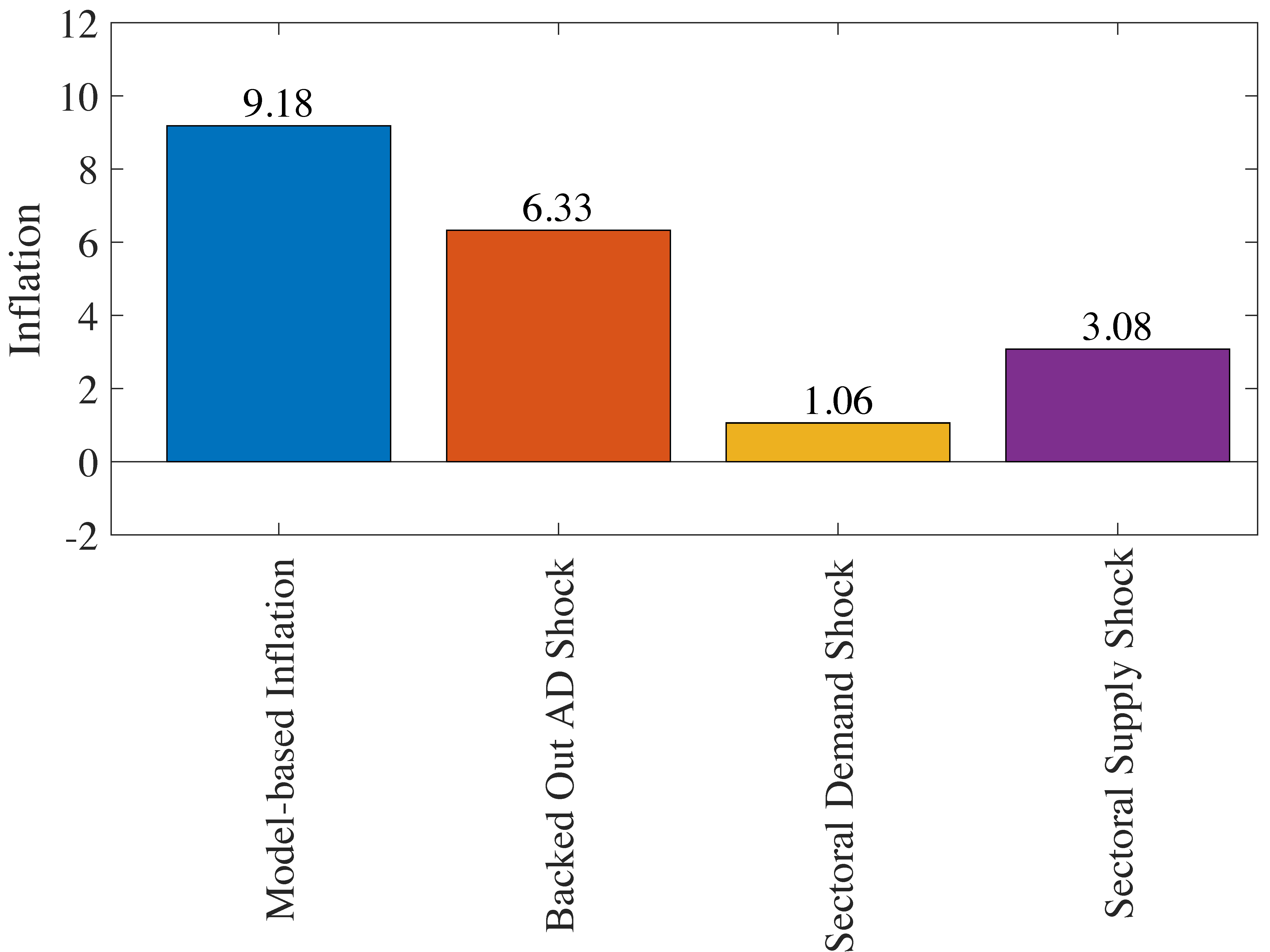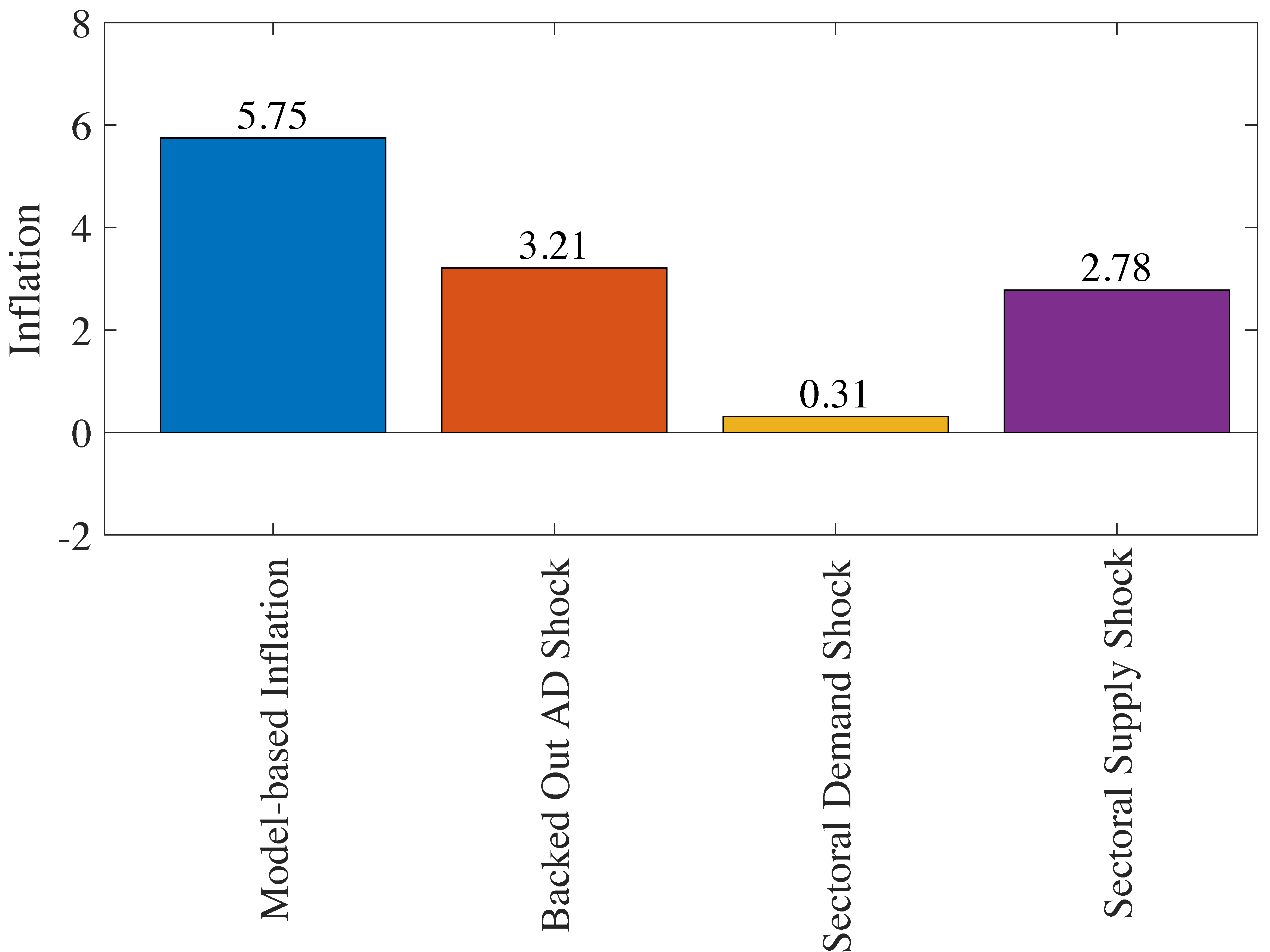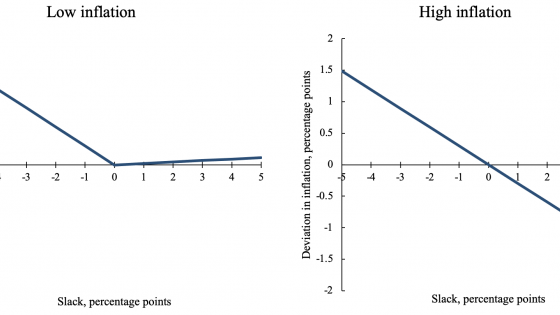The COVID-19 pandemic triggered a series of economic shocks starting in early 2020. First, millions of people contracted the disease and were unable to work. Second, there were mass lockdowns aimed at containing infection rates. Third, there was a huge compositional shift in demand from services to goods as the service sector shut down and shifted back from goods to services during the recovery as the economy reopened. Fourth, governments attempted to buffer the economic downturn via massive fiscal support. The impact of all these shocks can be summarised by an initial deep global recession and collapse of world trade before a rapid ‘V-shape’ recovery with the rollout of vaccines and economies reopened. An interesting observation to note is that the original 2020 disruptions in the supply chains due to early lockdowns worsened during the recovery and reopening in 2021.
One painful and unexpected outcome of these dynamics has been stubbornly persistent inflation which has reached levels not seen in the US and the euro area over the last four decades. While it is well accepted that the pandemic shocks and policy responses led to supply and demand imbalances, which led to the current inflationary environment, we still know little about the quantitative importance of the different shocks in driving today’s inflation.
A growing literature has tried to provide a quantitative answer to this question for the US, with a reduced form econometric approach (e.g. Santacreu and La Belle 2022, Jordà et al. 2022 Shapiro 2022). Our recent work (di Giovanni et al. 2022) is the first to formally quantify the importance of demand and supply shocks in explaining the ‘Covid inflation’ through the lens of a structural model. Specifically, we ask how much of the observed inflation between 2020 and 2021 in the US and the euro area was due to either supply and/or demand forces. We use a multi-sector network general equilibrium model developed in Baqaee and Farhi (2022) to answer this question. We chose to focus on the 2020-2021 period to better isolate the pandemic effects on inflation, and not conflate them with the Ukraine-Russia war that has impacted world food and energy prices. Studying both the US and the euro area is interesting for several reasons. First, these major economies provide excellent laboratories to apply the model given data availability for the two areas. Second, the US and euro area had heterogeneous policy responses, which may have implied differing importance of supply versus demand shocks in driving overall inflation. Therefore, contrasting the two cases provides interesting perspectives for policymakers to consider moving forward.
The Baqaee-Farhi model allows us to decompose the drivers of inflation into three different sets of shocks:
- Sectoral supply shocks, such as those induced by the lockdowns that reduce the labour supply in different markets;
- Sectoral demand shocks, stemming from the compositional shifts in consumption baskets observed during the pandemic; and
- Aggregate demand shocks due to, for example, from government transfers, monetary policy, or expectations about future states of the economy.
We work out an open-economy version, building on Cakmakli et al. (2022), to account for the global trade and production network connecting country-sectors with global input-output linkages. This structure helps us to study the effect of global supply chain bottlenecks on inflation.
In a single-sector world, inflationary effects of shocks to aggregate supply and aggregate demand are clear from a modeling perspective. In a multi-sector world, it is not immediately clear, when a series of negative sectoral supply shocks are combined with both positive and negative sectoral demand shocks, such as the ones caused by the pandemic. Furthermore, negative sectoral supply shocks can also reduce demand in other sectors due to input-output linkages. In such an environment, it is not clear if positive demand shocks and negative supply shocks are both inflationary. As a result, sectoral inflation/deflation may or may not map to broad-based aggregate inflation. Our multi-sector framework helps us to do this mapping, connecting sectoral price pressures caused by sectoral demand and supply imbalances to aggregate CPI inflation.
Figure 1 summarises our main findings. Each bar quantifies how much inflation would be observed if we include all three shocks simultaneously in the model (the first bar) or if we feed each shock into the model separately (the last three bars). Panel (a) shows that sectoral supply shocks drove roughly one-third of observed inflation in the US over the 2020-21 period. This result indicates that shocks corresponding to the sector-level supply constraints, such as chips and semiconductors, and the resulting spillovers via supply linkages played a non-negligible role in driving aggregate inflation. The remaining portion of inflation was generated by demand shocks, with most of the inflation stemming from the aggregate demand shock. For example, had the economy been hit by only sectoral demand shocks (i.e. due to the compositional shifts in consumption), inflation would have been around 1%, a significantly lower number than total inflation in the first bar. On the other hand, if the economy were hit only with an aggregate demand shock, inflation would have been around 6%, almost two-thirds of the observed inflation during the period (8.5%). Sectoral supply shocks generate by themselves around 3% inflation. These results suggest that although demand is more important than supply in driving inflation in the US during this period, the impact of supply bottlenecks played an oversized role, as they accounted for one-third of total inflation.
Panel (b) of Figure 1 highlights that the composition of inflation was different in the euro area. Sectoral supply shocks generate around half of the observed inflation during the period. Like the US, the aggregate demand component generates more inflation than the sectoral demand component. Hence, this suggests that the supply and demand sides were equally important in generating inflation in the euro area.
These results may not be surprising given the type of fiscal stimulus in the US versus Europe. In the US, aggregate demand stimulus took the form of stimulus cheques and help to firms and unemployment insurance, each around $800 billion. In Europe, in contrast, there were no cheques; instead, a central policy was to extend loans to firms that were supposed to be paid back within five years, preventing unemployment and bankruptcies.
Figure 1 Inflation under different set of shocks: US versus euro area
A) US
B) Euro area
We run three experiments using our open-economy model to assess the importance of foreign shocks and global bottlenecks in driving European inflation. The region’s reliance on foreign intermediates is the key channel for transmitting these shocks into the euro area. The structural model now considers three countries – the US, the euro area, and the rest of the world – and three sectors – durables, non-durables, and services. Our first experiment simulates inflation when sectoral demand, sectoral supply, and aggregate demand shocks happen in all three countries. Our second scenario assumes shocks only occur in the euro area, while our third scenario considers shocks outside the euro area alone. Figure 2 below shows inflation for each of these three scenarios. According to the model, inflation would have been 2% in the euro area at the end of 2021 if other countries had no shocks (orange bar). This result highlights the importance of foreign shocks, both supply and demand, in driving inflation in the euro area during the COVID-19 pandemic.
Figure 2 Euro area inflation in an open economy
Finally, we also revisit the seemingly conflicting issue of persistent supply chain bottlenecks and a fast recovery in trade. We show that trade elasticities vis-à-vis GDP are much lower for the US and euro area during the trade recovery period, relative to the recovery in trade in the aftermath of the 2008 Great Trade Collapse. This exercise provides suggestive evidence of how global supply chain issues hold trade back this time, relative to the 2008 episode that registers much larger trade elasticities.
Overall, our paper connects global inflation and global supply chain problems, highlighting that inflationary effects in any country will be greater when aggregate demand is stimulated in a supply-constrained world. Our quantification of inflation’s demand and supply drivers for the US and the euro area has important policy implications. For the US, coming down from 9% inflation to a target of 2% is a very different policy experiment than coming down from 6% inflation to the same 2% target. For the euro area, inflation would have been at the target of 2% without the global supply chain problems. As a result, a world with sectoral supply shocks will be inflationary, regardless of the fact that these supply shocks are domestic or international. Trying to reduce the impact of international supply shocks might lead to amplification of domestic supply shocks, which again will result in higher inflation. Pundits who argue for the benefits of nationalising supply chains and push for deglobalisation should take note.
References
Baqaee, D and E Farhi (2022), “Supply and demand in disaggregated Keynesian economies with an application to the covid-19 crisis”, American Economic Review 112(5), 1397-1436.
Çakmaklı, C, S Demiralp, S Kalemli-Ozcan, S Yesiltas and M Yıldırım (eds) (2021), “The Economic Case for Global Vaccinations: An Epidemiological Model with International Production Networks”, CEPR Discussion Paper No. 15710.
di Giovanni, J, S Kalemli-Ozcan, A Silva and M Yıldırım (eds) (2022), “Global Supply Chain Pressures, International Trade, and Inflation”, CEPR Discussion Paper No. 17449.
Jordà, Ò, C Liu, F Nechio and F Rivera-Reyes (2022), “Why Is US Inflation Higher than in Other Countries?”, FRBSF Economic Letter 7.
Santacreu, A M and J LaBelle (2022), “Global supply chain disruptions and inflation during the COVID-19 pandemic”, Federal Reserve Bank of St. Louis Review.
Shapiro, A H (2022), “How Much do Supply and Demand Drive Inflation?” FRBSF Economic Letter 15.









